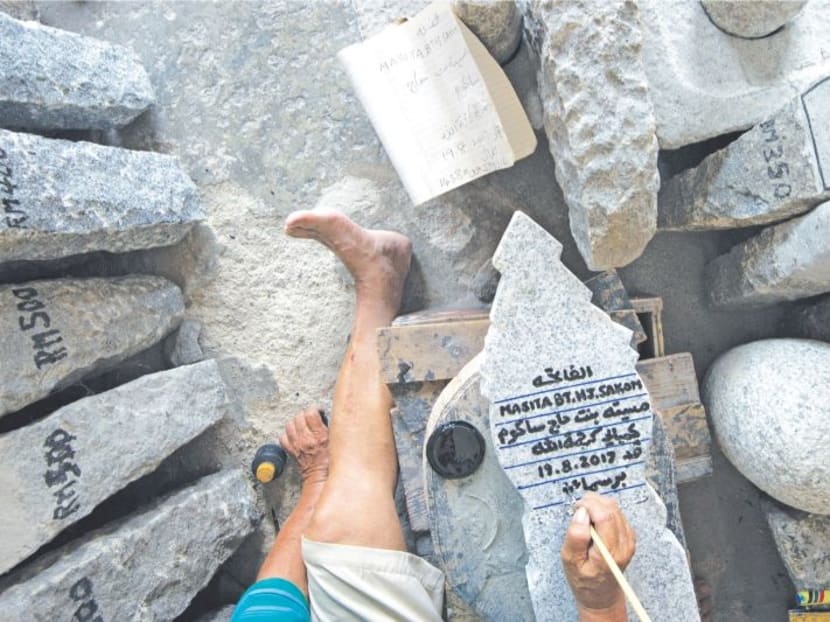Malaysian stonemason sees death of handcrafted tombstones
KUALA LUMPUR — Mr Kuah Leong Chuan is considered one of a kind.

Mr Kuah seen here carving epitaphs using the calligraphy ink as a guideline to make deeper incisions for him to write over the inscription again so the ink stays. Photo: The Malay Mail.
KUALA LUMPUR — Mr Kuah Leong Chuan is considered one of a kind.
The 61-year-old is the only Chinese stonemason skilled in sculpting Muslim headstones or batu nisan in Malaysia, and is determined to continue this ancient craft.
English-educated and a Taoist, one would be perplexed as to how a man with his background ended up doing stone-crafting in the coastal town of Kuala Selangor which is rich in colonial history.
Growing up in a fishing village along the banks of Sungai Selangor in the early 1950s, there were not many jobs available.
Like others, Mr Kuah followed in his father’s footsteps into the family business after completing secondary school. He began familiarising himself with the craft at the age of 20.
His skills in stonemasonry were passed down from generation to generation, father to son, from the time of his ancestors in China.
Mr Kuah’s great-great-grandfather initially carved animal stone sculptures for Buddhist and Taoist temples in China.
“When he migrated to Malaya in the late 1800s, he brought his trade and skills with him. However, I never learnt statue sculpting from my father, so that knowledge is lost forever,” he said.
“Gradually we learnt tombstone carving around the 1950s, shortly after the end of World War II.”
The second of six siblings and with over 40 years of stone-crafting experience, Mr Kuah is able to read and write Jawi script, as well as read and write Bahasa Malaysia and English, and speaks Hokkien fluently.
“The first question people always ask me is where did I learn to read Jawi and I always find it amusing,” he said.
Mr Kuah said he learned the language through experience after being tasked with writing epitaphs in Jawi. He knows the correct characters to use for the headstones.
Mr Kuah’s makeshift workshop sits near a former water pumping station built by the British but has since been demolished and the area now overgrown with vegetation.
For his stone carvings, Mr Kuah uses superior granite. He has made such a name for himself that people from all over Malaysia come to him for hand-crafted tombstones for their loved ones.
However, changing times has led to most people seeking cheaper and machine-made alternatives from materials like limestone and cement.
“Granite is used in construction because it is a hardy and tough material. It will last very long and will not erode,” he said, adding that tombstones made of limestone or cement often crumble within a few months or years.
“We masons are able to identify the veins in granite stones so it cracks nicely,” he said.
He said it usually takes about three days to complete a headstone.
Asked why the crafted headstone was rough at the bottom and smooth at the top, Mr Kuah said the roughness allowed the stone to firmly grip the soil when embedded.
“A smooth surface will result in a tilted headstone whenever there is soil erosion,” he said.
Mr Kuah takes his responsibilities seriously when working on headstones as there are sensitivities and religious verses involved.
“Clients sometimes include prayers in the inscription and so I always ask them who will be responsible if someone defaces the headstone?” he said.
As a traditional stonemason, Mr Kuah utilises tools like the mason mallet, hand chisel and chipper.
His chisel and chipper have a diamond embedded so that they can break stones efficiently.
“Diamond is the hardest rock around. It allows me to break and smoothen stones with ease as granite is harder than limestone,” he said.
But demand for traditional handcrafted headstones has been declining since the early 1990s.
Mr Kuah is possibly the last of his kind as he does not see anyone succeeding him. It could be the end of the traditional stonemason.
“No one, not even my children, want to continue doing this. Back then it was different as there was not much else to do,” he said.
“The job requires tremendous patience and hard work and this discourages youngsters from learning the skill.”
Asked what has kept him motivated all these years, Mr Kuah said there was a Malay saying that went “sekadar suka-suka saja”, which translates into “just for fun”.
“You do it at your own leisure. When time is up, you pack up and go home before resuming the same routine the next day,” he said. THE MALAY MAIL ONLINE






